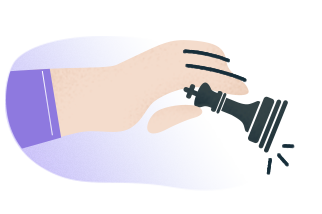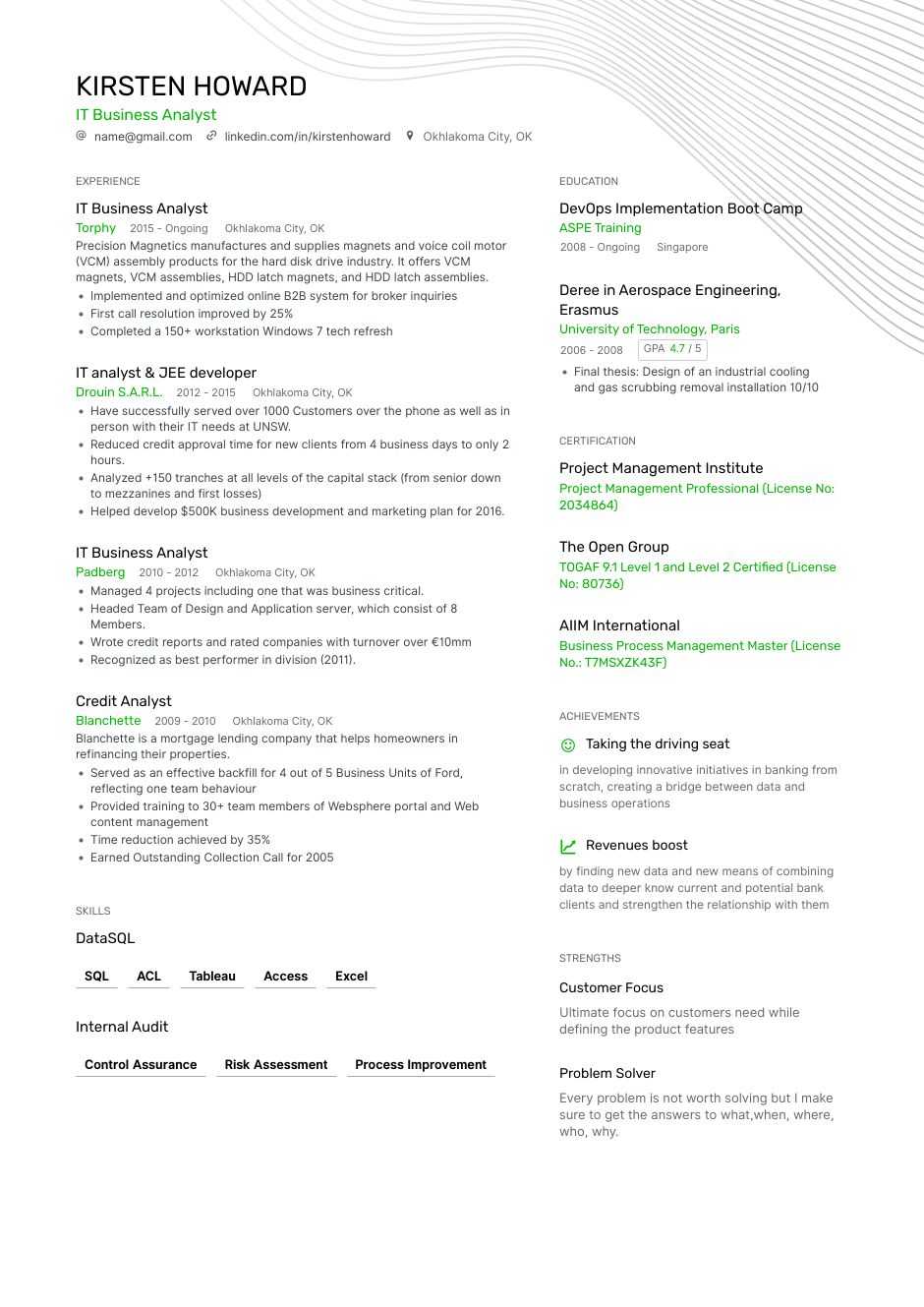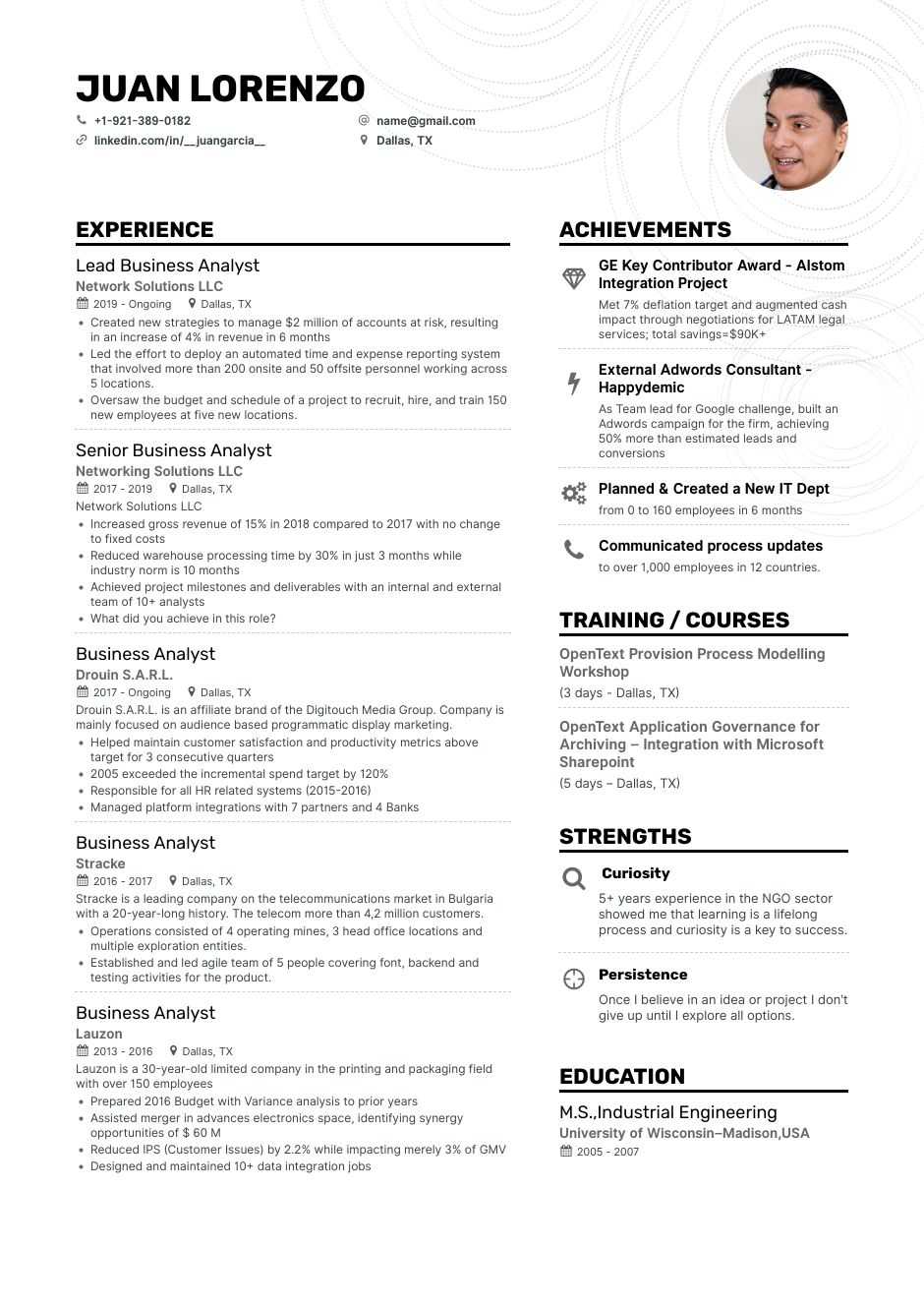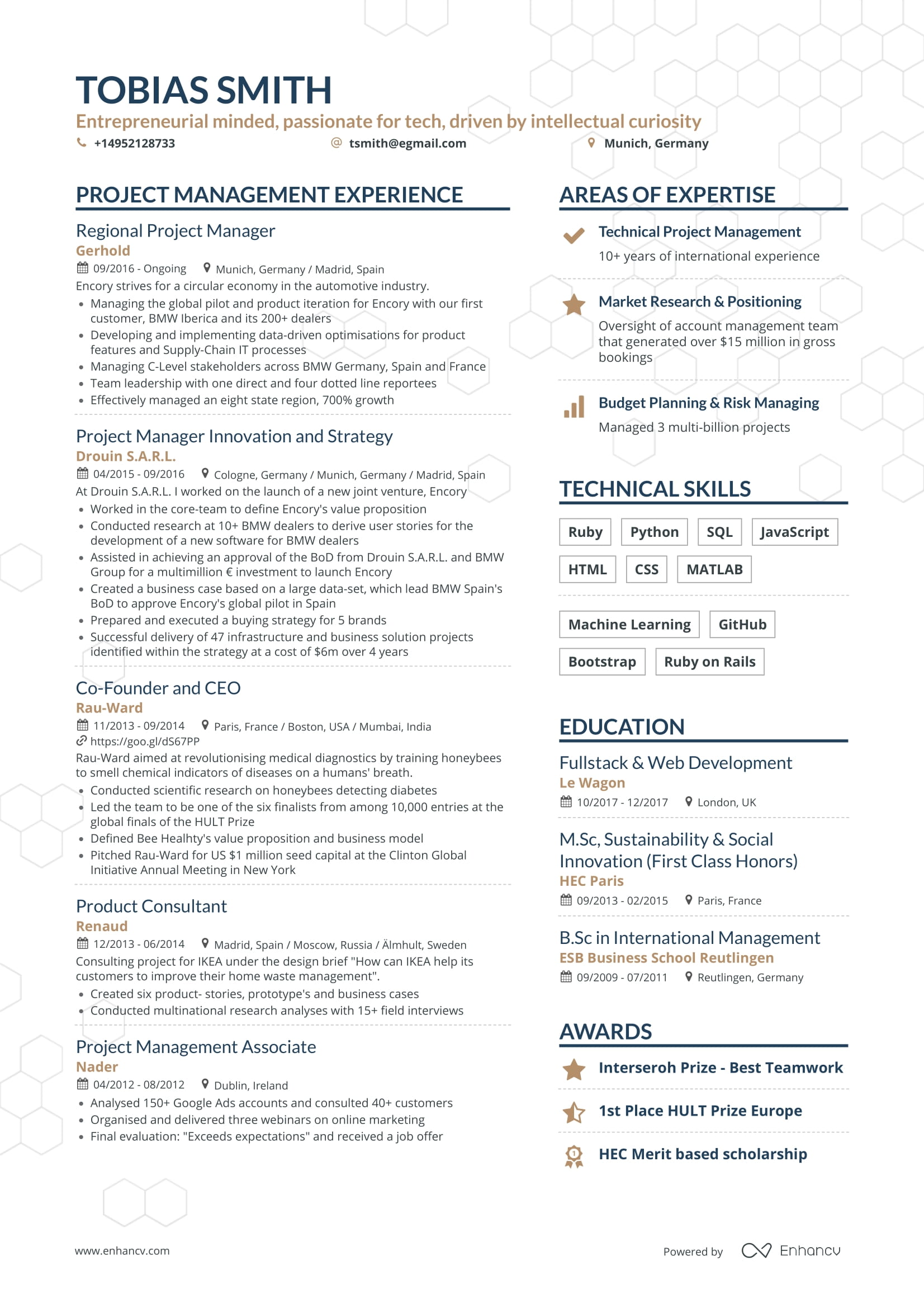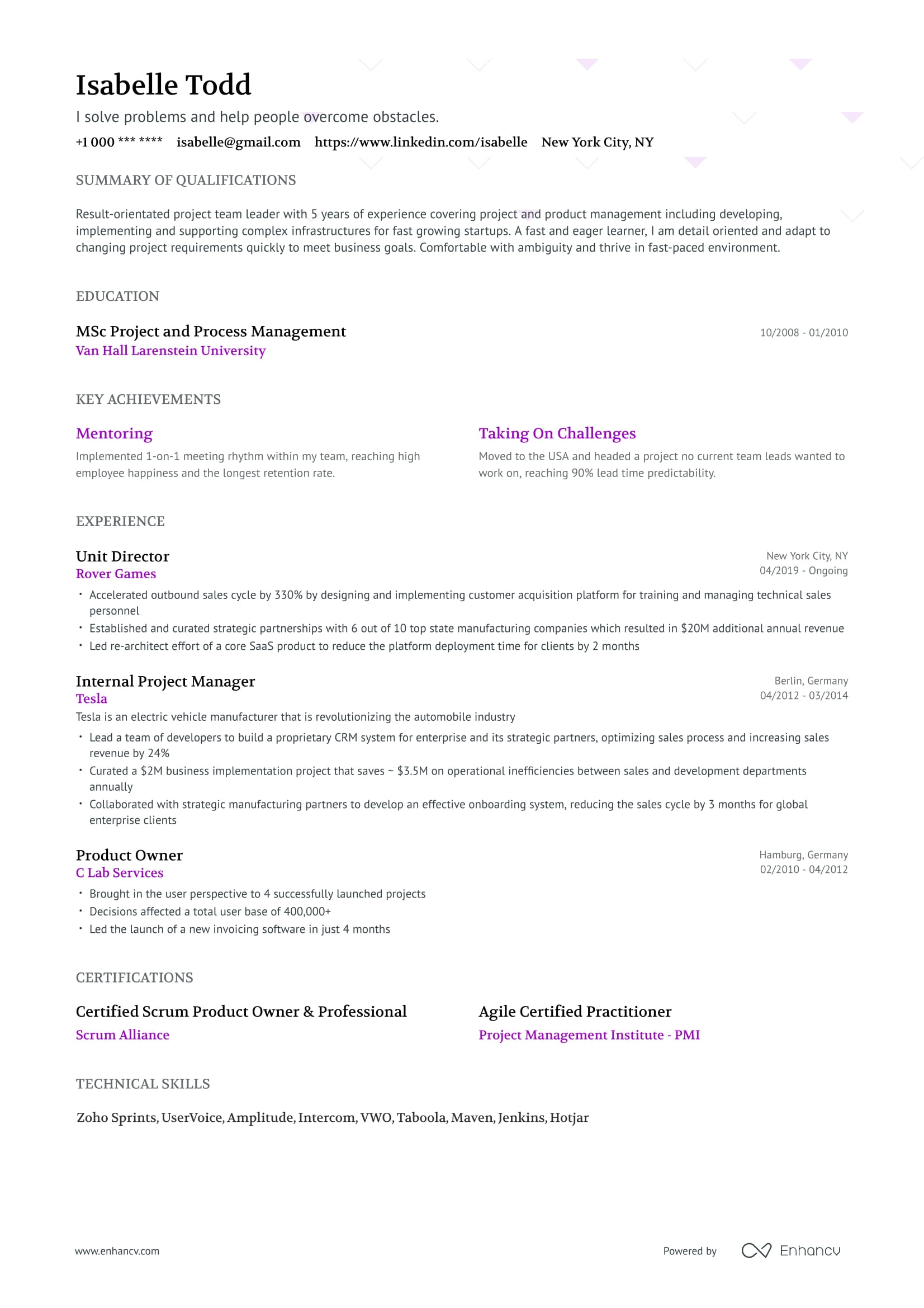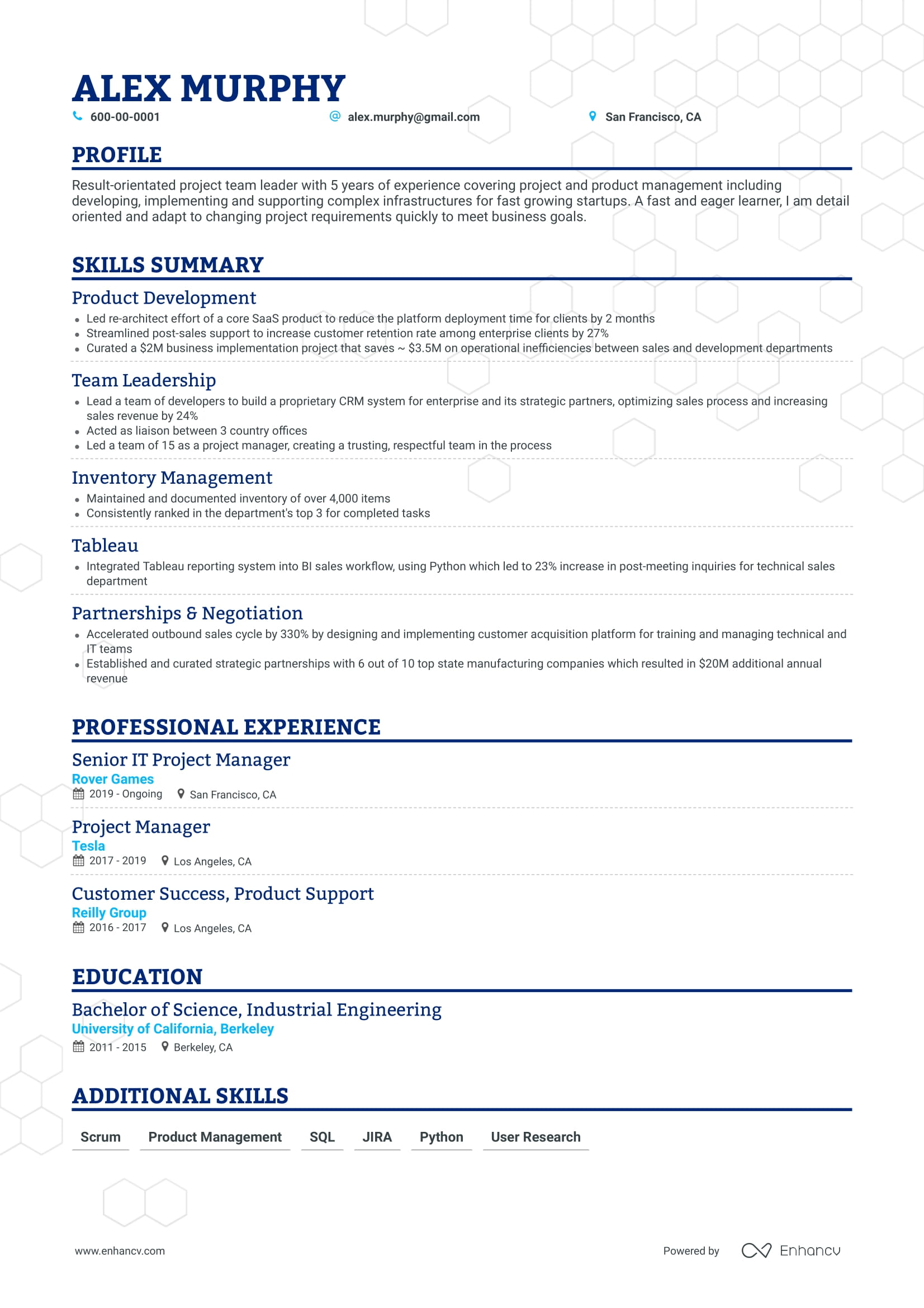Example Business Analyst Resume - Browse more resume templates and build a stand-out resume
You solve problems, analyze company performance, and suggest changes for improvement.
You know how to analyze data, create models, and use a bunch of technical tools.
As a business analyst, you play a huge role in a company’s growth.
The challenge is, how can you summarize this Herculean responsibility and the list of skills that go along with it in a well-formatted resume?
Your skills in analyzing data and turning them into bite sized reports will help you. Let this guide show you how.
Here’s what you’ll learn from this Business Analyst resume guide:
- How to pick the right combination of technical and soft skills that’s relevant for your role
- What to do when your target business analyst job is different from your previous role
- How to write bullet points that describe your technical skills and how it affected the company
- Compare and learn from 4 business analyst resume examples to find best practices to adapt for your application
Business Analyst resume samples
Senior Business Analyst Resume Example
Why this resume works:
- Shows experience working on multiple project types
- Shows business analysis planning experience
- It’s tailored to a hypothetical job description
IT Business Analyst Resume Example
Why this resume works:
- They prioritized their IT background
- Showcased multi-faceted IT involvement
Entry-Level Business Analyst Resume Example
Why this resume works:
- It makes the most of their transferable skills
- It’s tailored to the domain of expertise
- It has a previous relevant internship experience
Looking for related Business Analyst resumes? Check out our other profiles
How to write a Business Analyst resume: your main points
What’s the best format for a Business Analyst resume
You have a complex job. Explaining its intricacies and the good work you’ve done because of it will take space. On the other hand, recruiters hate text-heavy and condensed resumes.
That’s why it’s best to use a reverse-chronological or combination resume.
Areverse-chronological resume does well in highlighting impressive career trajectories or promotions.
If you want to highlight your skills,go with a combination resume format. It organizes your achievements into different skill buckets at the top of your resume.
It’s an advantage for seasoned professionals because the recruiter won’t be able to tell if an achievement took place two years or nine years ago.
Sections to include in a Business Analyst resume:
- Header
- Summary
- Work history
- Technical and soft skills
- Education
What recruiters are looking for in a Business Analyst resume:
- The right combination of skills in analysis, software, frameworks, databases, and testing
- A track record in analyzing data, and creating new processes to improve performance in different areas of the company
- Relevant certifications or degrees
- A growth mindset that knows the value of testing different methodologies when implementing new solutions
- Soft skills that show you can get management to buy into your proposed solutions
Here are moreresume tips regarding yourlayout andstyle:
- Clear and legible 12presume font size;
- Use 10’’resume margins - that’s default for a great resume design;
- Use aone-page template resume length if you’ve got less than 10 yrs of experience; Otherwise, opt for atwo-page resume;
- Pay attention to yourresume spelling - don’t lose your interview chances on a technicality;
- Save your resume as PDF before sending it to the recruiter.
Check out how yourresume can stand out without leaning too much on thecreative side.
For more information on the best resume formats, read our guide:The Best Resume Formats You Need to Consider (5+ Examples Included).
How to write a noticeable Business Analyst resume header
Listing your correct contact information and LinkedIn profile URL is standard advice for writing a resume header.
Your resume’s current header might look like this:
Customize your email, job title, and your LinkedIn URL to stand out from the competition. It’s a good way to insert extra keywords in your resume, too.
In some cases, Business Analysts are sometimes called as Functional Consultants,Product Managers, orIT Analysts. Remember to use the right job title.
If you want more ideas for stand-out resume headers, read through our guidePerfecting Your Resume Header so You Get Noticed.
You have the recruiter’s attention now. Keep them hooked with an eye-catching resume summary.
What it takes to make your Business Analyst resume summary stand out
Including notable achievements in your Business Analyst resume is obvious advice.
What exactly qualifies as a notable achievement, though?
Business Analyst roles differ from one industry to another, so it pays to specialize. Even within the same industries, companies have different processes and terminology. Because of these, specificity is important when writing your Business Analyst resume.
Consider the 3 Business Analyst resume samples below:
This summary doesn’t indicate what industry you worked in—much less the tasks you did.
This summary is an improvement because it shows the specific tasks you’re familiar. But there’s no gravitas. No impact.
The best Business Analyst resume summary includes both tasks and a measurable result. Here’s an example:
For more tips on crafting an attention-grabbing resume summary, check out our guideResume Summary: How-To Guide (30+ Examples You Need To See).
Business Analyst Resume Experience Section: Charming Recruiters With Style
The professional history section is the main course of your resume. Fill it with relevant experience and achievements.
But don’t just leave it at that. Go beyond the usual expectations with these tips:
Find the right balance between jargon and layman's terms
This is where it gets tricky.
In big companies, a recruiter might do a paper-screening to pre-qualify applicants first. But for startups or small businesses, a manager or a Senior Business Analyst will be the one reviewing your application.
How will this affect your Business Analyst resume?
There’s a chance one person reading it may only have a vague understanding of your role. Some recruiters are only given a list of skills or keywords to look for when pre-qualifying applicants.
Worse still, they may not even understand the jargon at all.
Where do you stand then?
Belcak advises candidates to examine the job ad to hone in on the skills, tools, and projects the employer wants to see.
This way, you don’t have to worry about a recruiter who’s just basing their decisions on a keyword checklist. You’ll also pass the scrutiny of a potential manager who understands the minutiae of your work.
It also helps if you use the industry-accepted terms on your Business Analyst resume. For example, your previous employer might’ve conducted "beta tests" to get feedback before launching a software or service.
Beta test might’ve been the popular jargon within your company. But other companies refer to this process as "data testing," or "end-user testing." It’s also generally known as "user acceptance testing."
Show a Range of Skills
Some Business Analysts work in finance, technology, or healthcare. Some Business Analysts are only expected to analyze numbers. Other business analysts also oversee the implementation of their proposed solutions.
Don’t let this discourage you from applying to roles not related to your current work. Think of it as having a bigger market for your diverse skill set. For instance, if your IT Business Analyst resume explains how your skills are transferable in a finance or warehouse operations, it shouldn’t be a problem.
Typical transferable responsibilities include:
- Creating detailed reports outlining the company’s current performance, goals, resources, and performance gaps
- Planning and monitoring performance or resources
- Forecasting
- Variance analysis
- Creating and modifying workflow charts
- Identifying project requirements and scope
- Improving current system practices
- Statistical and predictive analysis
- Analyzing market trends and uncovering opportunities for growth
Show Results
Companies hire you to improve their performance so you have easy access to whether your work helped or not. There’s no excuse not to share the tangible outcome of your efforts.
Below are different ways to show results on your Business Analyst resume:
- Percentage of improved output or productivity for warehouse operations
- Increase sales for front line sales teams and marketing efforts
- Decrease in refunds or cancellations
- Decrease in surplus for supply chain operations or retail businesses
- Decrease in bugs or customer complaints for SaaS based on user activity data
If you’re having trouble pinpointing the outcome of your work, ask yourself "So what?" What happened because of the market research study you did? What happened as a result of the sales forecast you wrote?
Keep asking yourself "so what" until you get to the bottom of the situation.
Demonstrate Specialization
As mentioned in tip #2, Business Analysts can find work in a variety of fields. But if you’re not happy with your field or want a higher salary, you can specialize in a specific line of work.
For instance, some Business Analysts specialize in IT companies or investment companies. Others specialize as an Enterprise Resource Planning (ERP) Business Analyst.
If you have the experience, it’s easier to tailor your resume to specialize in a specific field.
If you don’t, you need to review multiple job postings, along with resumes and LinkedIn profiles from other Business Analysts in your target field. Review your previous projects, too. Find out where you can connect them to the skills, tools, or experience needed for your chosen specialty.
This tutorial explains this process in greater detail, specifically step one.
Now that you know what to do, it’s time to see what those changes look like in an actual resume.
2 Business Analyst resume experience examples
Below is a Business Analyst work history sample that lacks all four of the suggestions above.
What’s wrong with the example above? Anyone who reads it will ask, "So what???"
So what if they poured through thousands of product listings on Amazon? What came out of that? Did it benefit the sellers or buyers in any way? Did it benefit Amazon?
Context is important. It shows why your task was crucial and how it impacted stakeholders. Otherwise, you might as well be a theoretical number cruncher.
Belcak analyzed hundreds of resumes from his audience and students. From this, he found that the most effective bullets consist of:
- 45% industry terms
- 15% action words
- 15% measurable results
- 25% common words
Here’s what the Business Analyst resume sample above looks like if rewritten based on this formula:
All bullets above show results, not just in money earned or saved but in other aspects of the business, too.
Belcak’s finding suggests allocating 45% of words to industry terms. This isn’t limited to jargon. Product stocking and quality control are both used in the retail industry, and yet you don’t have to work in that industry to know what it means.
Check out ourHow to Cover Work Experience On Your Resume guide for more tips on building a job-winning experience section.
Need Entry-Level Business Analyst resume tips?
Let me clue you in on a little secret…
Those jobs ads that require one to two years professional experience are testing you.
Recruiters receive up to 250 applications for one job posting. So if you don’t apply because you don’t have all their "requirements," there’s less work for them.
Job ads that "require" one to 2 years for fresh graduates are flexible. The work experience requested here isn’t limited to corporate settings.
Coursework, extra-curricular activities, volunteer work, side projects are all viable ways to flesh out your entry-level Business Analyst resume.
Business Analysts often have a degree in Business Administration. Their coursework usually covers the gamut of business communications, financing, operations and policies.
Find out which of the job requirements are similar to your coursework and college projects, then write about that.
For example, if you see phrases like "develop performance benchmarks" or "improve operational workflow," then write about your coursework in business policy or business process improvement. That’s relevant experience right there.
Don’t underplay non-analyst roles or side projects, too. If while waitressing, you tested different phrases you can say to increase your tip, and shared it with other waitstaff, that’s another relevant accomplishment.
Just choose the right words when describing it. For example:
"Increased customer satisfaction by X% after testing and iterating several customer-centric spiels"
Where increased percentage of customer satisfaction refers to increase in tips. The customer-centric spiels are the friendly or complimenting stuff you said.
Looking to build your own entry-level job resume? Follow the steps in our guideHow To Write Your First Job Resume.
This is how you should talk about your skills on your BA resume
You might’ve held a role where your focus was on building financial models. But the job you’re applying for now is more on prototyping and benchmarking performance. You have both skills, so which should you include on your resume?
The key is to start with the job ad. Prioritize the skills mentioned there by listing it at the top of your skills section. You can even divide them up by business function, or simply by soft and hard skills.
Top 21 technical skills for Business Analyst resume
- Agile development
- Automated testing
- Business process improvement
- Benchmarking
- Eclipse
- Data integrity testing
- Defining project scopes and solutions
- Financial analysis and modeling
- Functional testing
- Javascript
- Joint application development
- Lucidchart
- Logic modeling
- Market research
- PHP
- Predictive analysis
- Risk analysis
- Oracle
- SCRUM
- SQL or MySQL
- UML
How to describe soft skills on your resume:
A recruiter won’t believe you’re a good collaborator simply because it’s listed as a soft skill on your resume.
You have to prove it. Describe a situation where you used those skills at work.
These are the most wanted Business Analyst soft skills on resumes
- Teamwork
- Attention to detail
- Problem-solving or troubleshooting
- Organization
- Verbal and written communication skills
- Analytical skills
- Integrity
- Flexibility
Are you still not sure what skills will win recruiters over? Check out our guide onHow to Create A Resume Skills Section To Impress Recruiters (+10 Examples You Need to See).
Should I add an education section to my resume?
List your degree, school’s name, and location. Don’t list the year you graduated if it was more than 10 years ago. List academic achievements such as your GPA, a Cum Laude, or other awards, if you’re a fresh graduate.
There’s no specific degree required, as it depends on what the job entails. Many jobs posted online will ask for a degree in Business Administration, Business Management, or Information Technology.
Candidates applying for a senior or management role are often required to have a Master’s in Data Science or in Business Analytics, according toStudy.com. Senior roles often perform complex and cross-functional analysis. High-level mathematics combined with machine learning taught in these courses equip candidates with the skill set required for such demanding tasks.
Browse more essential tips on how to feature education on your resume, in our guidePerfecting the Education Section on Your Resume.
Consider these 7 Business Analyst resume certificates
Top 7 Business Analyst certificates for your resume
Yes, these certifications cost money and they take time to complete. You don’t have to invest in them when you’re straight out of college.
When you’re ready to level up your career, a comprehensive course and a worldwide recognized certification from any of these institutes can definitely change the game for you.
For more information on how to properly list resume certifications, we recommend reading our guideHow To List Certifications On A Resume (Examples Included).
Other sections to include on your resume
Depending on the company, job seniority level and your location, you may want to include more sections to your BA resume:
- Language skills
- Hobbies and interests
- Projects
- Volunteer work
- Highlights
- References
- LinkedIn on Resume
- GPA
- Resume Awards
- Publications
Cover Letter for a Business Analyst
In case the job description says you need to provide a cover letter, do include yours. Otherwise, you can always leave it out.
Nowadays, job application forms include questions like “why do you want to work here”, or “explain why you’re the best fit for us”, which makes you wonderare cover letters really necessary?
Still, they help youtell your story in a way that, if written right, it’s captivating and engaging.
In any case, you should pay close attention to the following tips when a cover letter is a must:
- Make sure you go over acover letter checklist, not to forgetwhat your cover letter should say;
- Match thecover letter design with your resume’s;
- Address your cover letter properly;
- Keep an eye on yourcover letter length;
- Use a propercover letter ending;
If you need more inspiration, check out thisCover Letter for Business Analyst example.
Key takeaways to write an interview-worthy Business Analyst resume:
- Don’t be afraid to showcase the wide range of your skills and professional experience
- Help the recruiter and Senior Business Analyst understand your work by including context when describing your work.
- Don’t forget to show off your soft skills. Even if your role is heavy on analysis and numbers, no one wants to work with a robot.
- Explain how your accomplishments translate to good work and less training for your target employers.
